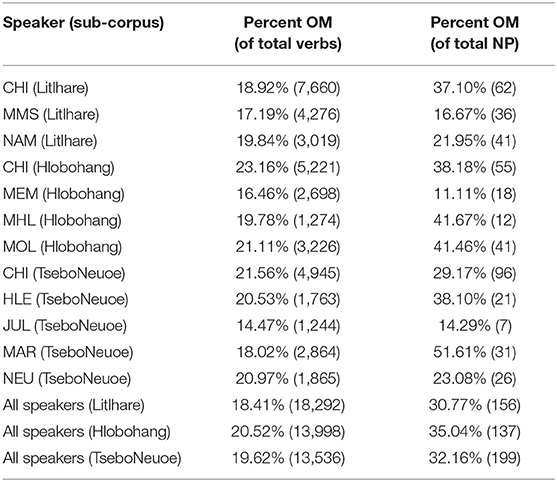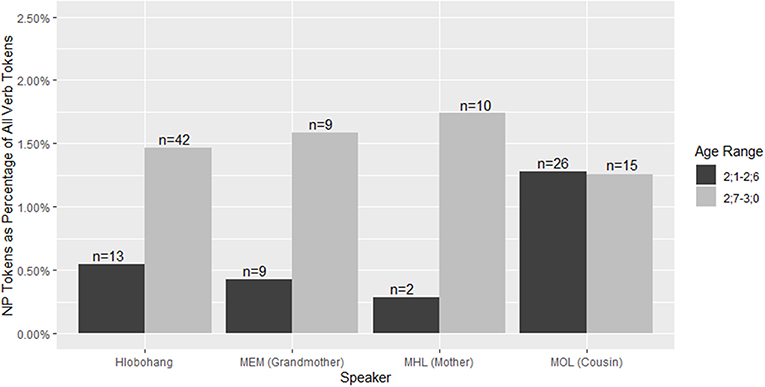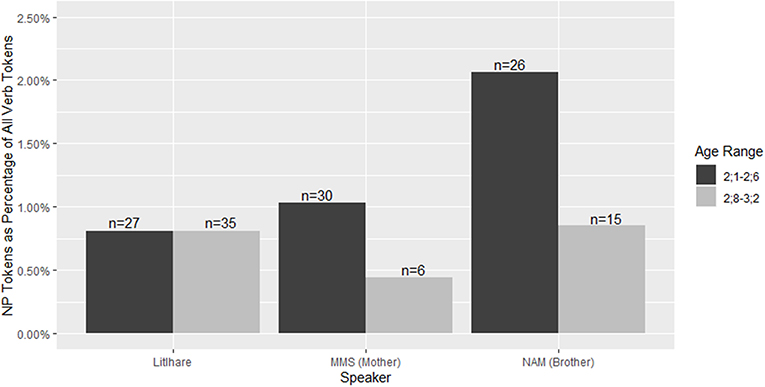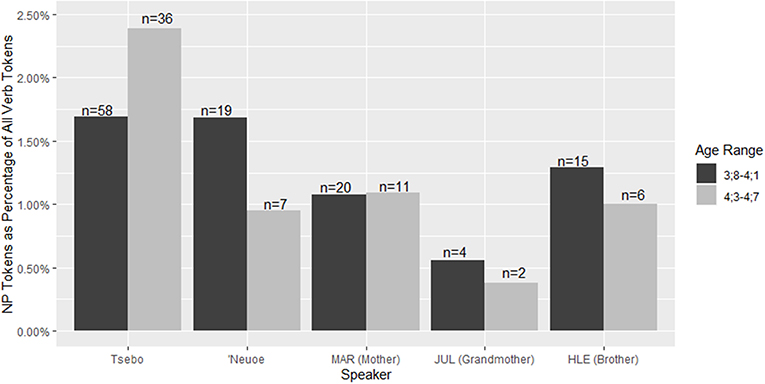- 1Department of Linguistics and Language Practice, University of the Free State, Bloemfontein, South Africa
- 2The MARCS Institute for Brain, Behaviour and Development, Western Sydney University, Penrith, NSW, Australia
- 3Department of Linguistics, Macquarie University, North Ryde, NSW, Australia
This study investigates a low-frequency verbal inflection called the “narrative past” in child and child-directed speech in the Bantu language Sesotho. Since the function of the Sesotho narrative past is not well-described, this study aimed to illuminate both function and acquisition trends in the Demuth Sesotho Corpus (Demuth, 1992). The narrative past form has been assumed to be under-specified for tense, comparable in function to the better-known Swahili -ka- inflection. The Swahili form, in turn, has been said to function in “clause chains” that are functionally and structurally similar to such chains in Papuan and other languages. We expected that, if the Sesotho narrative past is indeed functionally similar to Swahili -ka-, its distribution in child-directed speech and acquisition by children may pattern similarly to tense-less verb forms in non-Bantu clause chaining languages such as the Papuan language Nungon, where such verb forms can comprise over 20% of all verb tokens in child-directed and child speech at age 3;3. This study thus examined the conversational interactions of four children acquiring Sesotho in a village setting, aged 2;1–4;7. All 492 tokens of the narrative past form were coded for syntactic and discourse categories. Results show that the Sesotho narrative past generally occurs in much “looser” discourse chains than the clause chains of languages like Nungon; for Sesotho, other turns or elements can intervene between narrative past-framed mentions of previously-introduced topics. Further, the Sesotho narrative past has very low frequency in both child and child-directed speech, representing <3% of all verb tokens for both registers. There is possible evidence that one of the target children uses the Sesotho narrative past in increasing proportions as his linguistic sophistication increases, but there is no significant corresponding proportional increase in child-directed speech. Thus, in function and distribution, in both child-directed and child speech, the Sesotho narrative past form differs greatly from tense-less forms in more canonical clause chaining languages.
Introduction
Bantu languages are famous for their many verbal inflections. In particular, many Bantu languages boast multiple nuanced distinctions within the past and future tenses (Nurse, 2003, 2008; Botne and Kershner, 2008; Nurse and Devos, 2019), with, in some cases, a “Near Future,” “Middle Future,” and “Remote Future” tense with (presumed) application to different sections of a timeline. But the actual functions of these different tenses are often under-described, in both pedagogical grammars and academic literature. Corpus-based studies of verb inflection functions are rare (Crane, 2011, 2015; Sarvasy, 2016; Persohn, 2017). Even a small case study in corpus-based investigation of tense can reveal that seemingly straightforward labels such as “Near Future tense” fall short of encompassing the range of functions of a verbal inflection. For instance, Sarvasy (2016) showed through a small corpus study that the Near Future tense form (but not the Middle or Remote Future tense forms) in the northeastern Bantu language Logoori (Bantu, Guthrie code: JE41) has extended functions as a general future tense. The few corpus studies examined thus support the need for rich empirical documentation of the functions of Bantu “tense” inflections; such documentation could confirm the proposition by Botne and Kershner (2008) that a drastically different schema may be necessary for understanding the semantics of “tense” inflections in Bantu languages.
To make the situation even more complex, many Bantu languages have verbal inflections that look like tense-aspect categories in their morphophonology, but which do not introduce temporal contrasts (Welmers, 1973). These are often called dependent tenses or subjunctives (especially for Southern Bantu languages, cf. Doke, 1927; Cole, 1955; Doke and Mofokeng, 1957; Guma, 1971; Posthumus, 1991). The so-called “narrative tenses” form part of this group and typically indicate the continuation of a macro-event with sub-events or a contextually-connected sequence of events, like the sub-events of a typical story or a narrative description of steps taken toward an outcome (e.g., I planted the maize, then I watered it, then I…). While these are commonly referred to as tenses, they differ from other tense inflections in that they do not independently dictate a temporal setting for an occurrence, but simply indicate continuity of a previously established temporal context. They thus diverge from the cross-linguistically accepted notion of “tense” as in Comrie (1985), but will be referred to as “tenses” here for compatibility with the Bantuist literature.
Nurse (2008, p. 120–123) describes narrative tenses across Bantu languages as having a number of generalizable properties. Formally, narrative tense forms can be marked through a morpheme in the usual tense slot which is semantically and functionally empty, through an additional pre-verbal morpheme that may derive from a conjunction “and,” through a particular tonal melody, or, alternatively, through a zero morpheme in the usual tense slot. Functionally, they typically occur in a sequence of one or more verbs in the narrative form following a single initial non-narrative tense-marked overtly (or implied) on the first verb. The first verb, inflected for a more temporally-specific tense, introduces the temporal reference or broader time frame for the entire sequence. The narrative tense verbs in such a sequence thus serve as the predicates of clauses with overt external arguments.
While narrative tenses are most typically found in past temporal contexts and often described as past tenses in the literature for specific Bantu languages, Nurse claims that this distribution is discourse-related, rather than due a semantic “past” feature of these forms. Within the past time frame, the narrative category can be analyzed as reducing or eliminating distinctions made between time periods in the past. In Nurse's view, narrative tenses inherently convey sequentiality and relate to foregrounded, not backgrounded, situations, in Hopper's (1979) sense, where foreground information moves the main event line forward (Payne, 1992), and background information does not.
Swahili (Bantu, Guthrie code: G42) has a narrative tense morpheme -ka- which is typically sequential and used for past tense contexts (though see Contini Morava, 1989; Shirtz and Payne, 2015). This form is normally used for foregrounded events (Nurse, 2008) and contrasts with -ki-, which is used for backgrounded information, and ku-, which is used for non-sequential events that take place in the same general timeframe. Swahili examples illustrating the use of -ka- and ku- are in (1) and (2).
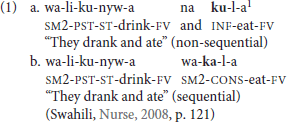
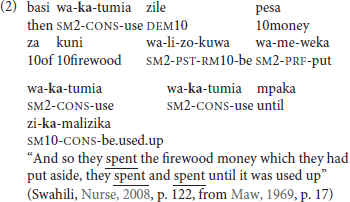
Cross-linguistically, a similar phenomenon to narrative tense sequences in Bantu languages is known as the “clause chain” (Longacre, 1985, 2007; Dooley, 2010, inter alia). Clause chains are sequences of clauses with verbal predicates that are under-marked for tense, mood, and sometimes subject person/number and other categories, preceded or followed by a single clause with verbal predicate with full tense, mood, and subject marking. As with the Bantu narrative tenses, clause chains in other languages tend to be used to relate a series of foregrounded events. Clause chains are found in hundreds of languages in diverse language families around the world; most particularly, in Amazonia, New Guinea, North America, and a cluster of language families from Turkey and the Caucasus through Central Asia and to the Asian Pacific coast (cf. cross-linguistic overviews in Bickel, 2010; Dooley, 2010). Most languages with clause chaining have verb-final constituent order within clauses, and in many it is the last clause in a clause chain that has full tense or mood marking. In contrast, the Bantu narrative tenses are similar to the minority of clause chaining languages in which it is the first clause of the chain, not the last, that has full tense marking. In fact, the Swahili -ka- inflection is cited in much literature on clause chaining as the prime example of this less-common clause chain ordering (Haspelmath, 1995; Longacre, 2007; Dooley, 2010).
Clause chains in many other languages, such as some of the Papuan languages of New Guinea, require strict adjacency of clauses within the chain. Backgrounded material can occur within clauses in the chain, but the clauses in the chain must occur one after the other. While multi-speaker constructed clause chains are attested in conversation between adults and between adults and children in the Papuan language Nungon (Sarvasy, 2015, 2017), these are generally limited in length to two turns. With the exception of the special case of a parent prompting a child to repeat a clause chain, clause by clause, as in the Nungon child speech corpus (Sarvasy, 2019b), the vast majority of clause chains in Nungon conversation begin and end within a single turn by a single speaker. A typical Nungon clause chain is in (3); while this comes from a monolog narrative, its length and structure are well-attested in conversation as well.

In (3), each clause ends in a verb that bears no tense morpheme and only inflects for its own subject person/number when the subject of the following clause is anticipated to differ from the subject of the present clause. There is a unified prosodic contour to the utterance, with relatively stable pitch until the last verb of the chain, which features a marked fall in pitch. Analysis of a subset of 1742 clause chains in Sarvasy's corpus of Nungon adult narratives revealed that clause chains have extremely consistent distributions in the narrative genre, such that a Nungon single-speaker narrative text of 13:20 min in length can be reliably expected to include between 120 and 150 clause chains. This fits with reports from other Papuan languages, notably Korafe (Farr, 1999), where, as in Nungon, discussion of sequences of related events and actions is almost guaranteed to involve clause chain structures.
Bantu narrative tense “chains” differ from clause chains in these other languages in several ways. First, as noted above, the Bantu chains begin with the clause that gives full tense specification for the rest of the chain, while in most other languages, that clause falls at the very end of the chain (Longacre, 2007). Second, in many other clause chaining languages, the verbal predicates in clauses that lack tense specification can lack subject inflection and other morphological characteristic of fully-inflected verbs. These forms are often called “converbs” or “medial verbs” (Delancey, 1991; Haspelmath, 1995; Longacre, 2007; Amha, 2010; Dooley, 2010, inter alia). In Bantu languages, however, verbs inflected for narrative tense bear obligatory subject prefixes just like other verbs; and rather than the absence of a morphological “slot” for tense, there can be a morpheme in this slot that does not function to demarcate specific temporal context. Further, while the distribution of clause chains in Nungon and Korafe is predictable in narratives, Bantu narrative tense sequences have less predictable distribution in narratives (shown for Logoori by Sarvasy, 2019a), and much lower frequency overall than in Papuan languages like Nungon, or possibly other clause chaining languages.
Beyond their ordering, associated morphology, and corpus distributions, Bantu chains of narrative tense verbs seem to represent a much looser chain type, if they are to be considered chains, than clause chains in languages like Nungon. In Bantu languages, unlike in the Nungon example in (3), once the temporal context has been established, subsequent clauses framed in the narrative tense can occur in separate prosodic groups. The narrative tense can also be freely used by other speakers continuing to speak within the same context. In fact, according to Nurse (2008, p. 120), such a chain can even be discontinuous, with use of the narrative tense “suspended and then deliberately reintroduced by the speaker to stress continuity.”
One of the aims of the present study was therefore to evaluate the form, functions, and distribution of the narrative tense form in the Bantu language Sesotho, which is relatively well-described within the family, and for which a large corpus of natural speech exists. This corpus (Demuth, 1992) comprises 98 h of child-peer and child-caregiver/family member interactions for four main target children. It thus enables us to pursue a second major question: how does the narrative tense form pattern in child speech and child-directed speech in Sesotho?
Little is known about the acquisition of clause chaining sentence structures in languages that have them. Initial results indicate, however, that children acquiring the Papuan language Nungon are exposed to frequent clause chains in child-directed speech from early in their language development, and that they produce a range of short two-clause chains well before age 3, as in (4), by the child Towet Oe, acquiring Nungon in a village context:

The tense-less verb forms that serve as predicates of all but the final clause in a Nungon clause chain are called, following the Papuanist tradition (traced to Pilhofer, 1933), “medial” verbs.
A case study of Nungon verb acquisition (reported in Sarvasy, 2019b) showed that medial verbs consistently represent between 14 and 31% of all verb tokens in adult speech directed at one child, aged 2;1–3;3. By age 3;3, the child herself was producing medial verbs in similar proportions to her parents. These results are visualized in Table 1.
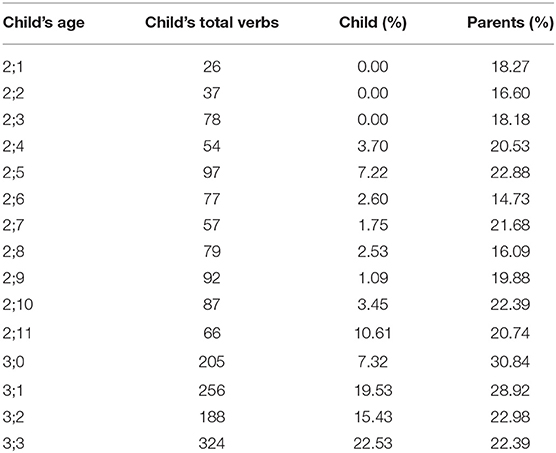
Table 1. Percent medial verb distribution of all verbs in child speech and parental child-directed speech in a Nungon (Papuan) case study (cf. Sarvasy, 2019b, p. 1080, 1081, 1085).
As seen in Table 1, the child's relative explosion in verb tokens around age 3;0 corresponds to an increase in the proportion of all verb tokens that are medial verbs. By 3;1 and beyond, the child's proportion of medial verb tokens falls within the adult range of 14.73–30.84% of all verb tokens. This can be taken to indicate that the child now produces clause chains with a distribution similar to that in her parents' child-directed speech in the same period.
Given the functional and distributional differences between narrative tenses in some Bantu languages and medial or other non-tensed forms in more typical clause chaining languages, the present study aimed to evaluate the acquisition patterns of the Sesotho narrative past in the broader context of clause chaining languages, including Nungon. We expected that, given the apparent differences in adult distributions between Bantu narrative tense chains and clause chains in languages like Nungon, children may show later acquisition of the narrative past form in Sesotho than in Nungon, and lower proportions of this form among all verb uses.
The Sesotho Narrative Tense
Sesotho is a Bantu language (Guthrie code: S33) with about 13.5 million speakers in South Africa and Lesotho (Eberhard et al., 2019). It has official status in South Africa and Lesotho and is used in education and media in both countries. Major reference works on Sesotho structure include Doke and Mofokeng (1957); Guma (1971), and Du Plessis and Visser (1995). Sesotho morphosyntactic acquisition has been documented in several studies (e.g., Demuth, 1987, 1989, 1992, 1995; Demuth et al., 2005, 2009, 2010). The only existing Sesotho natural speech corpus is the Demuth Sesotho Corpus (Demuth, 1992), henceforth DSC, which is the data source for the present study.
Sesotho has a complex TAM and negation system, even when compared to other Bantu languages (Gowlett, 2003). There are several past and future tense forms, a number of aspectual markers which can be combined in numerous ways, and also auxiliaries or deficient verbs that can appear before a lexical main verb that add a number of additional temporal, aspectual or modality related distinctions (Doke and Mofokeng, 1957; Gowlett, 2003, p. 631–636). While Sesotho is fairly well-documented in general, its TAM system is under-described, especially in terms of: (i) a detailed description and analysis of the functions of, and morphosyntactic and semantic restrictions on, most of its TAM morphemes (but see Morolong, 1978), (ii) the tone patterns2 associated with the various TAM categories (though see Khoali, 1991 for tonal patterns of various types of clauses), and (iii) discussion of the conjoint/disjoint system (though see Letšeng, 1995). The conjoint/disjoint distinction is widespread across Bantu languages, including Sesotho, where the present tense has two variants: a conjoint and a disjoint form. The use of the conjoint/disjoint form depends on whether a verb is in clause-final position and is sensitive to focal properties of the material following the verb, the details of which vary significantly across languages (an up-to-date, cross-linguistic overview of this phenomenon is provided in van der Wal and Hyman, 2016). Most commonly across Bantu, conjoint/disjoint distinctions are marked for the present and perfective verb forms (for example, Sesotho morphologically marks only the present disjoint with -a- in prefix position and the present conjoint with a zero morpheme).
Sesotho has a tendency to stack TAM markers, often by adding auxiliaries which show subject agreement, but several prefixes attached to a single verb are also possible. The auxiliaries with subject agreement can be seen in example (5):

The Southern Bantu languages of the Nguni and Sotho-Tswana groups, including Sesotho, have a narrative past form which is marked with -a- in the prefix position (Posthumus, 1991). Posthumus analyses this form as describing sequential or consecutive events. For Sesotho, the narrative past tense is described only in passing in Jacottet (1912), Doke and Mofokeng (1957), and Ferreira (1964). Gowlett (2003) only notes that what he calls the past and future “consecutives” should not be confused with the narrative. Khoali (1991, p. 262) refers to a different tense as the “participial narrative past.”
The Sesotho narrative past is referred to as “past subjunctive” in Doke and Mofokeng (1957). In their terminology, this relates to this tense's being a dependent tense—i.e., one which needs another tense to set the initial time reference—not to any irrealis-type meaning. Chaphole proposes calling the form a “past narrative” instead of past subjunctive (Chaphole, 1988, p. 140), but mostly lists forms modified by additional auxiliaries or conjunctions, with only one example of the unmodified narrative past tense. Other sources do not engage with the function or meaning of the narrative past at all. It uses a prefix -a which is affixed after the subject marker and coalesces with the vowel of the subject marker. The final vowel is -a. The form and basic discourse use of the Sesotho narrative past are shown in (6).

Sesotho has at least two other TAM categories marked with an a-prefix: the remote past and the present disjoint. In addition, a-prefixes are used with the subject markers for noun class 1 (for some tenses) and 6, and the object marker for class 6, all of which can appear adjacent to one another. This makes it somewhat challenging to confirm that the form has been identified accurately in a written transcription, especially given that vowel length and tone marking is absent from most of the literature and not marked in the DSC (though the sound files are linked and available in the CHILDES data exchange system, and TalkBank: see footnote 3 below). Moreover, the examples from Southern African languages in the linguistic literature, when published in Southern African books or journals, are typically not glossed.
The tones are not properly described in any of the sources listed above (though see comments on tone in Doke and Mofokeng, 1957, p. 236). There does seem to be agreement that this form has a short vowel (unlike the remote past, which has a long vowel with the same vowel quality in the same position). Letšeng (1995, p. 135–7) labels this tense as séquentiel positive en -a “positive sequential with –a” and lists tonally-distinct conjoint and disjoint forms. Based on Letšeng's descriptions, we can conclude that verbs in the narrative past have the following tonal melody: if the verb root has a lexical high tone, this tone spreads to the following syllable, but only if the verb stem is trisyllabic or if the verb is followed by an object (Letšeng, 1995, p. 135–7). This kind of tone spreading is commonly found across Bantu languages (see also Demuth, 1993).
Most sources treat this tense as not having a conjoint or disjoint distinction, if such a pattern is mentioned at all. Creissels (2016) discusses the implications of tonal conjoint/disjoint patterns, beyond morphological conjoint and disjoints forms, in Sotho-Tswana, and we refer the interested reader to this source.
The annotational system used in the DSC accepts that the narrative past can be directly negated, as in (7).

Such a negative form of the narrative past is mentioned as a rarer alternative form to the -nga- negative for Zulu in Posthumus (1991, p. 93), and Letšeng (1995) gives no negative form for the Sesotho narrative past. Doke and Mofokeng (1957) note that there is no negated equivalent of this tense or the tense that they refer to as the subjunctive perfect, but that a negative form of the auxiliary ka, shown in (8), can be used with a verb marked for the narrative past. They do not discuss the semantics of this form.

Morolong (1978, p. 29) has examples of a form, shown in (9), that is similar to that glossed as the negative narrative past in the DSC, but she never discusses the narrative past itself or what this negative form is. Malete (2003, p. 29) also lists this form, which he refers to as the negative perfect. Doke and Mofokeng (1957, p. 203) list a negative perfect/past with the same morphological structure and note that there is no coalescence between the prefix and the vowel of the subject marker. This means there is a difference in segmental structure to the form included in the DSC, which has coalescence of the -a- prefix with the vowel of the subject marker with the pattern ha-SM.a-root-a. This suggests that the form in (9) is not a use of the narrative past, but rather two consecutive main clauses.

Doke and Mofokeng (1957, p. 237) further note a number of contexts in which an apparently narrative past-marked verb form can be used: after the auxiliaries -hla (10a), -ile (10b), -ka, and -ke; after the potential tenses; after commands or requests including their respective negative forms; and after certain conjunctions. They also claim that the auxiliary construction in (10b) is the most common way of expressing the past tense in Sesotho (Doke and Mofokeng, 1957, p. 266). The translations given in Doke and Mofokeng (1957) for these combined forms make clear that these verbal complexes are not semantically or pragmatically functioning as narrative past forms. Morolong (1978, p. 49) analyses the auxiliary construction in (10b) as the “remote past” and shows that it cannot be used with adverbials such as “today” or “this morning.” In the original DSC annotation system, these constructions are coded as past, not narrative past. We follow the DSC schema here and treat the narrative past-like form in these constructions as distinct from the narrative past form elsewhere.

A small number of tokens analyzed as narrative past in the DSC include the auxiliary ba or be (11); Doke and Mofokeng (1957, p. 238) also mention a “subsequential” prefix nt'o that can be used with the narrative past. There are no examples of the latter in the DSC and too few examples of the forms with ba or be to attempt to offer an analysis of them here5.

With this background in mind, we turn to the present study.
Methods
The data were taken from the Demuth Sesotho Corpus (DSC; Demuth, 1992), a longitudinal speech corpus of 98 h of Sesotho naturalistic child and child-directed speech recorded in a village setting, transcribed, and annotated. More information on the DSC is available in CHILDES (MacWhinney, 2000). The corpus includes spontaneous daily interactions between four target children and their mothers and other family members in and around the children's homes, which were all located in a single small rural community in Lesotho. Interactions were audio-recorded in 3–4 h sessions monthly over about one year in 1980–1982. The target children were: Litlhare (female, 2;1–3;2), Hlobohang (male, 2;1–3;0), ‘Neuoe (female, 2;4–3;3), and Tsebo (female, 3;8–4;7). The DSC is divided into three sub-corpora, one each for Litlhare and Hlobohang, and one with transcripts that include both Tsebo and ‘Neuoe, cousins living in the same household. The data were annotated by native Sesotho speakers together with Demuth, following CHAT formatting, and searched using CLAN tools (MacWhinney, 2000). For each utterance, three additional coding tiers were added: %gls to give the morpheme boundaries within the Sesotho, %xcod for morpheme-by-morpheme glosses, and %eng for a free English translation. Situational context is occasionally noted in a fourth tier, %sit. For this study, we had access to the original audio recordings (digitized) and the coded transcriptions, which are all freely downloadable from CHILDES. As there were no video recordings of the interactions, it was sometimes difficult to determine the exact nature of the interactions and thus a challenge to establish the linguistic context. This also means that discussion of discourse functions in the present study was based largely on clues in the linguistic record and the notes on situational context when available.
Throughout the DSC, the narrative past was coded as t∧np (meaning, tense = “np”) in the %xcod tier. For the present study, all transcripts were searched using the CLAN search function for t∧np in the %xcod tier. These were then compiled into a single.cha file for each sub-corpus. A total of 492 tokens were found: 137 in the transcripts for Hlobohang, 156 for Litlhare, and 199 for the combined TseboNeuoe sub-corpus. The resulting 492 tokens contain a range of lexical verbs, including both intransitive and transitive verbs in derived and underived forms, and a range of semantic classes. These are partially illustrated in the examples in the first Results section, including: intransitives (11), transitives with (12b/13c) and without objects (10b), lexical ditransitives (14a), applicatives (27a), causatives (17b), passives (16a), and statives (19c). We then annotated the tokens for several additional features to explore syntactic and discourse-related functions and distribution of the form.
For each token, an additional coding tier was added to the .cha files. Each was then coded for the presence of absence of 27 morphosyntactic and discourse features (listed in the Appendix). These features were selected based on their relevance for encoding information structure6 and phrasing in other Bantu languages (c.f. Buell et al., 2011a, and articles/chapters in Buell et al., 2011b; van der Wal and Hyman, 2016) but excluding phonological indicators such as tone and other prosodic information, such penultimate lengthening, which are not marked in the DSC. The aim of this additional coding was to obtain parameters for the morphosyntactic and pragmatic functions of the narrative past, including focus marking or phrasing and, potentially, marking the status of objects that appear with t∧np forms as arguments/topics.
Results: Syntactic and Discourse Functions of the Narrative Past
The narrative past form appears in 1.07% of all verb tokens for all speakers in the entire DSC. Each sub-corpus differs somewhat in the overall frequency of the narrative past form across child and adult speakers: the Litlhare sub-corpus is the lowest with 0.85% of all verb tokens in the narrative past form, while the figure is 0.98% in the Hlobohang sub-corpus and 1.47% in the TseboNeuoe sub-corpus.
Many of the 27 codes showed no clear distributional patterns that might be related to functions of the narrative past. There was no clear relationship between WH-questions, for instance, and use of the narrative past form vs. other verbal inflections. Two of the criteria we coded, however, do show striking patterns, and are discussed here: “topic chains” (single or multi-speaker and topic continuity, in the following section), and object marking (in the subsequent section).
Sesotho Narrative Past Loose Discourse Chains
In this section, we give an overview of how the Sesotho narrative past form occurs in discourse, looking at the types of chains, temporal use and setting of the temporal reference frame, topic continuity, sequential and non-sequential event use, its use in foregrounded or backgrounded events and co-occurrences with negation. In the end, almost all tokens in the corpora for Hlobohang and Tsebo and ‘Neuoe were analyzed as occurring within “discourse chains.” In these chains, the narrative past form is used to refer to a broad “discourse topic” (simply put, something discussed in conversation) that was already introduced using a different tense form in the same utterance or earlier. The “discourse chain” concept stems from the literature on clause chaining in Swahili, where clause chains are expected to begin with an overt scene-setting verb that occurs no more than 1–2 clauses before the “narrative tense.” In fact, we originally used this as our coding criterion for discourse chains, resulting in the marking of 84–94% of all narrative past tokens in the three corpora, with the lowest percentage in the Litlhare sub-corpus. But when we turned to examine the narrative past tokens that had not been coded as occurring within discourse chains under the original criteria, we found that, with very few exceptions, these also could actually be considered to occur within discourse chains, with the original mention of the discourse topic even earlier than two clauses before.
A more close-range discourse chain is illustrated in (12), where the first utterance (12a) uses the perfective form, and the second utterance (12b) uses the narrative past; here the context is two children playing with two objects, placing one (referred to by the class 9 subject marker in 12a) inside the other—a boot—and opening and closing the boot (referred to by the class 5 object marker in 12b) repeatedly.
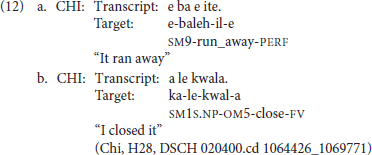
Often, discourse topic continuity spans multiple speakers, as in (13) and (17).
In (13), the context is various types of food, including biscuits, being given to a person.
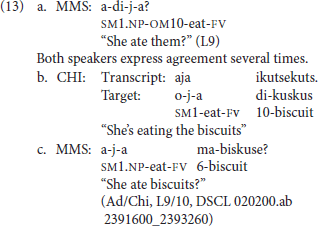
In (14), 14b is clearly a reaction and response by 7-year-old MOL to the request made by CHI in 14a, even though this is not a chain of topic continuity.
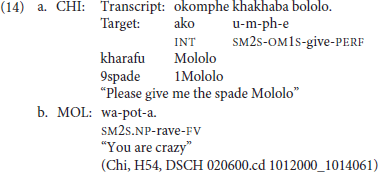
Examples (15) and (16) show additional narrative past sequences involving just one speaker, while (17) and (18) show other multi-speaker discourse chains.
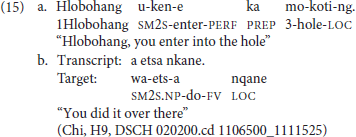
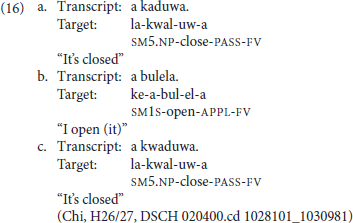
In the example in (17), three different speakers—one adult (JUL) and two children (CHI and NEU—i.e., Tsebo and ‘Neuoe)—use the narrative past with both sequential and non-sequential information. The sequence is immediately preceded by a verb form in the present conjoint tense (17a), but takes place in the context of the grandmother asking the children a series of questions about events which took place in the past, using a mixture of past- and present-inflected verbs.
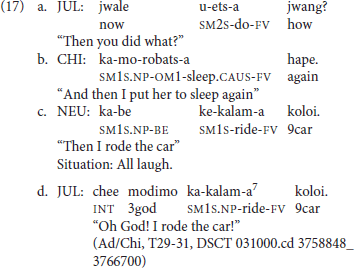
In (18), two children, 5-year-old NAM and his younger sister Litlhare (CHI here) use the narrative past form in one longer sequence on the same, uninterrupted topic (here, the speakers are eating corn mush and talking about porridge, corn and peas, all of which are in noun class 9/10, but it is not entirely clear from the transcript whether “it” refers to one of these or a different object).
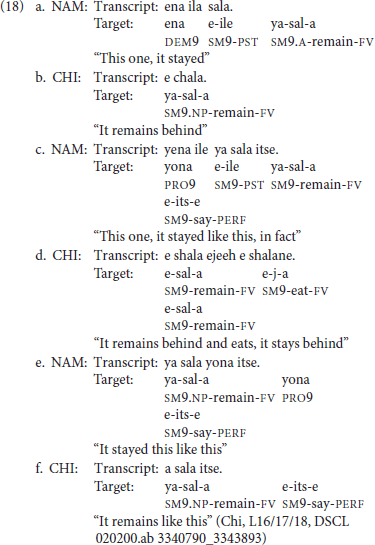
Persohn (2017) examines the two narrative tenses in Nyakyusa (Bantu, Guthrie code: M31) based on single-speaker narratives (such as traditional stories) and some elicitation of ungrammatical patterns, showing that in Nyakyusa the narrative tense can only be used in events which extend the main narrative. This kind of pattern is found in much but not all of our data. For example, in (19), the narrative past form is used for what seem to be the main events, not for describing background events. This may indicate that Sesotho differs from Nyakyusa in this respect.
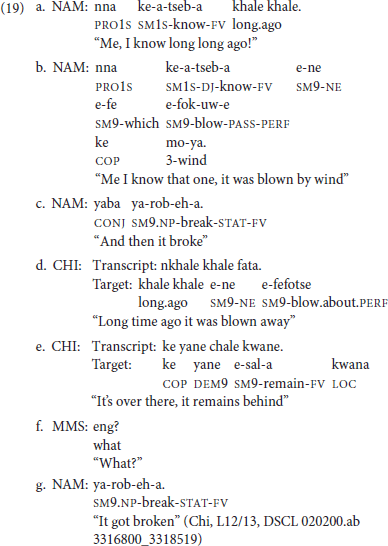
In contrast, in (20), the narrative past is used for backgrounded information: the “thing that passed,” rather than the main event (“entering”). But the exchange in (20) forms part of a series of comments made by the two children while playing, not a very clearly structured conversation. The DSC does not include single-speaker narratives of the type analyzed by Persohn (2017), so any conclusions about differences between Sesotho and Nyakyusa are tentative.

Another type of discourse chain found in the DSC occurs in a multi-speaker narrative, where several speakers are narrating the same event, often with the parents (such as MHL in example 21, who is Hlobohang's mother) asking prompting questions. An example of this is shown in (21). This is only part of a longer sequence of 14 narrative past forms that serve to narrate the same macro-event (a trip that the conversation participants took together).
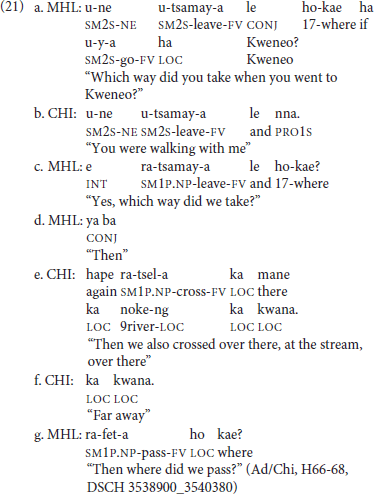
Crane (2015, p. 2) describes the use of switching between narrative and inflected forms in Totela (Bantu, Guthrie code: K41) as marking a change in the subject or topic within a discourse that can split a narrative into smaller events or mark a shift in viewpoint. In discourse, this might be used to shift back to an earlier topic. Indeed, this sometimes seems to be true of the DSC as well. In examples (22) and (23), speakers use the Sesotho narrative past to resume a disrupted topic: “buying candy” in (22) and “getting off the chair” in (23).
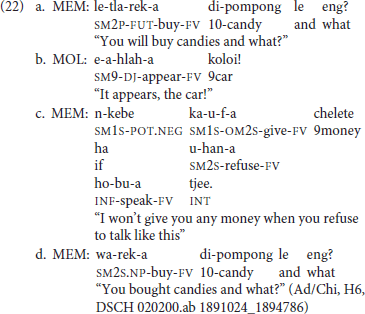
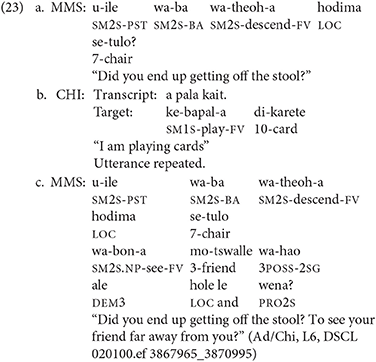
A small number of tokens glossed as narrative past in the DSC were not translated as being in the past tense by the original annotators. In some cases, the context had clear non-past reference. In example (24), mother and child are picking small stones out of dried peas, preparing them for a meal. In (25), and in the wider context from which this example was taken, there is a mixture of present and past reference. Here the narrative past-marked verb is preceded only by present tense forms and followed by a perfect/perfective form. In both contexts, sequentiality is seemingly relevant. This supports Nurse's (2008) claim that these forms are not actually specified for tense, but that a past reading is prevalent due to the nature of the discourse environment in which these forms are used, as both traditional stories and personal narratives overwhelmingly use the past tense.
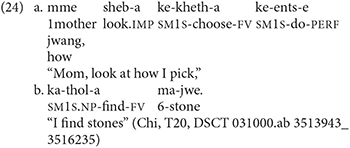
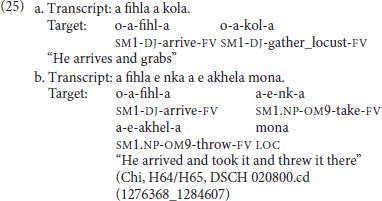
However, in at least some examples in the DSC, the narrative past, rather than any other past inflection, seems to serve to introduce past tense reference, as in (26).
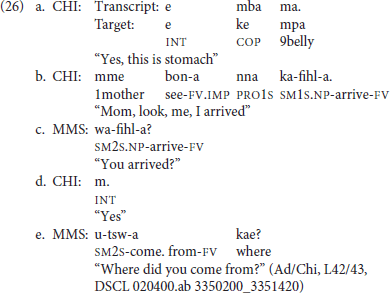
The narrative tense can also be the only form in a discourse context that is interpreted as having past reference. But in (27) there is additional visual/situational context.
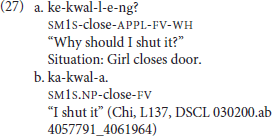
With a few tokens, there were no overt verbs that clearly serve to initiate a discourse chain context for the narrative past form. However, in (28), there is earlier non-verbal context for the chain. This kind of pattern is pointed out in Nurse (2008) for narrative tenses in Bantu languages in general.

The Sesotho narrative past can have sequential interpretations (29), or additive interpretations as in (30), where additional information is provided to the topic discussed that is not sequential. For instance, (30) provides more detail on how an object went missing.

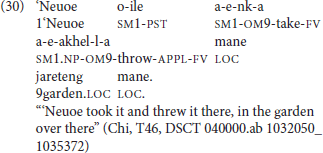
Unlike the patterns found in languages with more typical clause chain markers, in the DSC there is often just a single narrative past token per utterance, rather than a chain of narrative past and/or narrative past and other forms. Most tokens appear in sentences or utterances where the narrative past-marked form is the only verb, but narrative past-marked verbs also do occur before or after another verb marked with the narrative past in a single utterance, as in (31), or a verb in a different TAM form, as in (32).
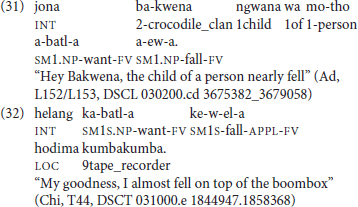
In (31) and (32), the inflected form of the verb meaning “want” is used to express that something nearly happened, not volition.
The narrative past also occurs in corrective or confirmative questions, as in (33). Many tokens in the DSC are repetitions or near-repetitions by the same speaker repeating themselves or another speaker repeating what the first said, which can take the form of statements or questions.
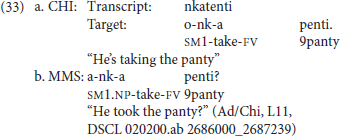
As discussed in the Introduction, there is some disagreement in the literature about the function of the negative narrative past form. Negative narrative past forms constitute a relatively large subset of the narrative past tokens in the corpus. The highest percentage of negative narrative past forms is in the TseboNeuoe sub-corpus with ~25%, 17% in the Litlhare sub-corpus and 12% in the Hlobohang sub-corpus (see following sections for more information on sub-corpora). In the DSC, lexical verbs introduced in the narrative past can be subsequently negated in the same stretch of discourse using either narrative past forms or non-narrative past forms. For example, a follow-up question to a statement in the narrative past in (34a) uses the negated form of a different tense in (34b), which is immediately followed by another token of the narrative past in (34c).
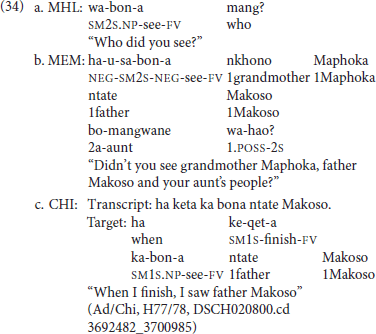
In (35), the negative form of the narrative past is used to negate the affirmative narrative past sentence in (35a).
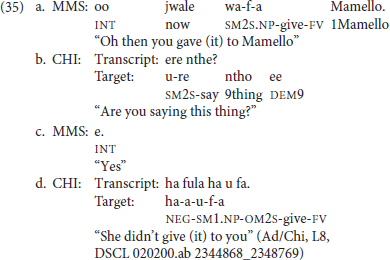
The data and discussion in this section show that the Sesotho narrative past is used in different kinds of chains and allows considerable flexibility, especially compared to clause chaining languages like Nungon, and possibly even compared to other Bantu languages, such as Nyakyusa, in terms of how it is introduced and how it interacts with surrounding discourse. Elicitation-based future research might narrow this somewhat and more comparative data would be helpful for shedding more light on how narrative tenses are similar or different in their use across the Bantu languages.
Object Marking With the Narrative Past Form
As in other Bantu languages, Sesotho verbs can mark the person/number or noun class of an object on the verb. Either of the two objects of a ditransitive verb can be marked on the verb, but only one object marker is allowed on a verb (Morolong and Hyman, 1977). Unlike object marking in Bantu languages like Swahili or Sambaa (Riedel, 2009), Sesotho object marking is not obligatorily when a co-indexed lexical object is present. The object marker is typically used, pronoun-like, to replace a lexical object that was introduced in the preceding discourse. An example of Sesotho object marking is shown in (36), where the object marker is indicated in boldface.
An unanticipated finding of our study is that object marking is very prevalent among the narrative past tokens, and object marking occurs in higher proportions of narrative past tokens than of all verb tokens for all three sub-corpora and most speakers8.

Results for object marker frequencies are summarized in Table 2. Here, the percentage of all verb tokens that have an object marker, and the percentage of all narrative past tokens that have an object marker, are compared for: (a) individual speakers in the DSC with more than 3 narrative past tokens, and (b) all speakers in each sub-corpus, including those who produce 3 or fewer narrative past tokens.
The percentage of narrative past tokens with an object marker is generally higher than the percentage of all verb tokens with object marking, except in the case of three speakers: MMS (Litlhare's mother), MEM (Hlobohang's grandmother), and JUL (Tsebo's grandmother). We ran two Mann–Whitney tests to explore the significance of these differences. In the first test, we compared the two proportions in Table 2 for only the individual speakers with more than 3 narrative past tokens overall. A two-tailed Mann–Whitney test run at a 0.05 significance level resulted in a U-value of 36, z-score of 2.05, significant at p < 0.05 (p = 0.04036). In the second two-tailed Mann–Whitney test, we again used the individual speaker percentages of object marking on narrative past tokens as one sample, but for the second sample, we included percentages of all verb tokens with object marking for all speakers with at least one verb token across all three corpora (hence, a much larger sample). In this test, the difference in percentages of object marking for all verb tokens vs. narrative past tokens was significant at p < 0.01 (U = 202.5, z = −3.04, p = 0.00236).
At present, we can only speculate about the possible reasons for this finding. Although DSC verbs are not coded for transitivity, narrative past tokens in the corpus tended to occur with a mix of both transitive and intransitive verb roots. Further, based on the literature and our reading of the DSC, we have no reason to expect that a greater proportion of narrative past tokens than of all verb tokens be transitive. Rather, we suggest that there may be a difference between transitive narrative past tokens and other transitive verb tokens in discourse use, resulting in the higher use of object marking with the narrative past. For instance, it could be the case that lexical objects are omitted more frequently with verbs in the narrative past form, possibly due to their previous introduction with verbs in other inflections. Object marking in languages with similar patterns to Sesotho has been argued to indicate the topic status (in the information-structural sense of topic of a clause; cf. Bresnan and McHombo, 1987; Demuth and Johnson, 1989). In a clause chaining context, we would expect more objects to be topics/discourse-old than in other types of discourse settings. The higher prevalence of object marking with the Sesotho narrative past could thus be related to these discourse differences.
Results: Acquisition and Child-Directed Speech
The use of narrative past forms as a function of all main verbs used was calculated for both the target children and for the adults and older children interacting with them. As in the preceding section, only speakers with more than three narrative past forms overall were included. These are binned below in Figures 1–3 into an earlier and later age range per target child. Overall, the narrative past was used with between 0.75 and 2.5% of all verb tokens produced by adults and older children across the three corpora. Hlobohang showed a possible developmentally-related increase to within the adult and older child percentage range, though this was not statistically significant, probably due to the overall low number of items. Litlhare used fewer narrative past forms than the other children, with slightly older ‘Neuoe using adult-like proportions, and the eldest, Tsebo, using slightly greater proportions than ‘Neuoe. Figure 1 shows the proportions for the Hlobohang sub-corpus, Figure 2 shows these for the Litlhare sub-corpus, and Figure 3 shows them for the TseboNeuoe sub-corpus. In all the figures, the total number of narrative past tokens is given above each bar.
In Figure 1, all speakers except for Hlobohang's 7-year-old cousin (MOL) show increases in their proportions of narrative past tokens between the first time period and the second. It could be that his grandmother and mother display fine-tuning effects (Soderstrom, 2007), tracking Hlobohang's developmentally-related increase in narrative past use. Alternatively, it could be that there was a slight increase in the proportion of discourse contexts for narrative past use in the later samples.
First, to investigate the significance of differences between narrative past proportional use in the two age ranges, we ran Mann-Whitney tests for each speaker on transcript-by-transcript proportions for the two periods. The results were not significant for any speaker (Hlobohang, U = 46.5, z = 1.16937, p = 0.242; MEM, U = 35, z = −0.2717, p = 0.78716; MHL, U = 43, z = −0.45584, p = 0.64552, MOL, U =, z = 0.03077, p = 0.97606). We then ran a Kendall tau correlation test for the pairs Hlobohang-MEM and Hlobohang-MHL to evaluate the possibility of a correlation between the child's apparent increase and those of the adults. Neither was significant, with tau = 0.22377, p = 0.27312 for the child-grandmother (MEM) pair, and tau = 0.26318, p = 0.20398 for the child-mother (MHL) pair.
Figure 2 offers no hint of a developmental increase for Litlhare in the proportional use of the narrative past, and neither her mother nor 5-year-old brother mirror her proportion of use across sessions. Mann–Whitney test results yield no significance in the differences in proportions of narrative past use across the two age ranges for any of the three speakers here (for Litlhare, U = 60, z = −0.27908, p = 0.77948; for her mother, MMS, U = 23, z = 1.56354, p = 0.11876; for her brother, NAM, U = 35, z = 1.37315, p = 0.17068).
Litlhare has been previously shown to be linguistically less advanced than Hlobohang: talking a lot, but not using as many complex grammatical structures such as relative clauses (Demuth, 1995). Her pattern of narrative past use may be similarly less advanced that that of some of her peers, or it is possible that the discourse contexts for the use of the narrative past were simply not sampled during the later recordings.
The final two target children, Tsebo and cousin ‘Neuoe, were recorded during interactions between themselves and with Tsebo's grandmother, whereas interactions with Tsebo's 5-year-old brother and mother were primarily with Tsebo alone. Their data is shown together in Figure 3, where only Tsebo shows a slight (non-significant) increase over time in her proportion of narrative past use. Here, the age ranges refer to Tsebo's ages, not ‘Neuoe.
Mann–Whitney tests on the age-related differences in proportions of narrative past use all showed no significant differences for the speakers in the TseboNeuoe sub-corpus: for Tsebo, U = 63, z = −0.09303, p = 0.92828; for her brother (HLE), U = 32.5, z = −0.9798, p = 0.32708; for her grandmother (JUL), U = 21, z = 0.32275, p = 0.74896; for her mother (MAR), U = 34.5, z = −1.56928, p = 0.11642; for her cousin, ‘Neuoe, U = 46, z = 0.59855, p = 0.5485.
In sum, this first-pass, descriptive analysis of Sesotho narrative past use by toddlers and their older siblings and caregivers shows that: (1) There is remarkably little variation across speakers in the proportion of narrative past tokens as a function of all verb tokens used, with an overall mean of 1.07%; (2) Both of the younger target children use the narrative past form before the age of 2;6; (3) None of the target children show proportions of narrative past tokens that diverge dramatically from those of adults and older children.
Thus, despite the few descriptions in the Sesotho linguistic literature, the narrative past form is used with high consistency across speakers, from adults to very young children. Interestingly, its relatively low frequency in adult speech does not appear to delay its acquisition, at least in the proportion of overall use.
Conclusion
This has been the first investigation into the Sesotho narrative past form in adult or child speech. Our findings show that the Sesotho narrative past patterns differently in its distributions and morphosyntactic behavior from more canonical clause chaining forms in other languages, including Bantu languages like Swahili.
The Sesotho narrative past form is a low-frequency form in the DSC, occurring in 1.07% of all verb tokens used. It is generally used by one or more speakers in a loosely-defined chain of utterances on the same topic, which can be sequential or not, including either foregrounded or backgrounded information. Its function in supporting the continuity of a discourse topic may be supported by the higher frequency of object markers found with this form. The form shows no apparent conjoint- nor disjoint-related marking. While past tense context for the narrative past form is by far the most prevalent in the present corpus, some tokens in non-past contexts confirm Nurse's (2008) proposal that past tense reference is not an obligatory feature of Bantu narrative “tenses.” For Sesotho, this could mean that a different label for the form would be more appropriate. Surprisingly, tokens of the narrative past form in this Sesotho corpus mostly occur in isolation rather than in the connected chains that appear to be more characteristic of the -ka- form in Swahili and of clause chains cross-linguistically. This might be influenced by the conversational and child-centered nature of the DSC, which does not typically feature longer narratives by a single speaker. Future research will have to ascertain whether the Sesotho narrative past form patterns differently in adult narratives compared to everyday interactions with young children.
The older children and adults in the DSC generally exhibited narrative past use of between 0.75 and 2.5% of all verb uses. The two older target children, ‘Neuoe (2;4–3,3) and Tsebo (3;7–4;7), both had proportions within the older child/adult range. For the two younger children, only Hlobohang showed a (non-significant) increase in use of the narrative past as he approached 3 years. Given the relative low frequency of the narrative past in the input these children hear, it is interesting that children appear to acquire this form and use from such a young age. But this is not an isolated case: the passive also occurs in about 2% of the input Sesotho-speaking children hear (Demuth and Kline, 2006; Kline and Demuth, 2010), and yet children use the passive productively in spontaneous speech by 2;8 years (Demuth, 1989), and in experiments showing comprehension, production and generalization to novel verbs by the age of 3 (Demuth et al., 2010). These (low-SES) children also show sophisticated uses of null noun class prefixes under appropriate phonological, syntactic and discourse conditions by the age of 2;6–3 (Demuth et al., 2009), as well as early sensitivity (age 4) to animacy restrictions on double-object applicative constructions that rarely occur in the input they hear (only 2 instances of non-pronominalized ditransitive applicatives in the 98 h of speech occur in the DSC; Demuth et al., 2005). Their use of flexible word order for discourse purposes is also well-underway by the age of 3 (cf. Demuth, 1987). Thus, these pre-literate children appear to be highly-tuned to multiple levels of linguistic structure from a very early age, using appropriate forms in appropriate discourse contexts. Taken together, the narrative past results presented here are perhaps not surprising. They also highlight the impressive learning mechanisms underlying these children's early language development.
Data Availability Statement
The datasets generated for this study are available on request to the corresponding author.
Ethics Statement
Ethical review and approval was not required for the study on human participants in accordance with the local legislation and institutional requirements. Written informed consent to participate in this study was provided by the participants' legal guardian/next of kin.
Author Contributions
HS and KR conceptualized and wrote the paper. KR coded and analyzed the Sesotho data. HS did the figures and statistical analysis. KD consulted on the analysis and statistics, and contributed to writing.
Funding
This research was funded, in part, by the following grants: NSF SBR-9727897, ARC FL130100014, and ARC DE180101609.
Conflict of Interest
The authors declare that the research was conducted in the absence of any commercial or financial relationships that could be construed as a potential conflict of interest.
Footnotes
1. ^Abbreviations used in glosses: 1, 2, 3, 4, 5, etc., noun class; 1SG, 2PL, etc., person and number; A, a-marker (when appearing in combined tenses or negative forms not in NP); APPL, applicative; BA, auxiliary; BE, auxiliary; BT, baby talk; CAUS, causative; CHI, target child; CONS, consecutive; COP, copula; DEM, demonstrative; DJ, disjoint; DS, different subject; FOC, focus; FV, final vowel; HAB, habitual; HES, hesitation; HLA, auxiliary; IMP, imperative; INF, infinitive; INT, interjection; LOC, locative; MV, medial verb; NE, form (past continuous); NEG, negative; NP, narrative past; NOC, nocturnal; OCC, occasional; OM, object marker (followed by noun class number or 1/2 person); PERF, perfective; PFR, perfect; POSS, possessive; POT, potential; PREP, preposition; PST, past; PRO, pronoun; S, singular (for first and second person subject/object markers); SG, singular; SM, subject marker (followed by noun class number or 1/2 person); SS, same subject; ST, stem marker; STAT, stative; TAM, tense aspect mood; WH, wh-clitic.
2. ^Bantu languages typically have different tonal patterns for each tense, aspect or mood which determine the tone of the subject marker and tonal melody of the verb stem. Apart from this, TAM distinctions may also be segmentally/morphologically marked in prefix and or suffix slots.
3. ^Examples taken from the Demuth Sesotho Corpus (DSC), are marked for child speech (Chi) and/or adult speech (Ad), and given a unique identifier from our dataset. In examples illustrating interactions between multiple speakers we include the speaker labels from the Demuth Corpus. Their source in the original Corpus is indicated as follows: DSC, followed by H for the Hlobohang corpus, L for the Litlhare corpus, or T for the TseboNeuoe corpus, followed by the file name and timestamp of the utterance. The full corpus, including audio files, is accessible and downloadable via the Childes TalkBank website: https://childes.talkbank.org/access/Other/Sesotho/Demuth.html. doi: 10.21415/T57P4N.
4. ^Glosses for data from the DSC are our own, based on the morphological tags and English gloss in the transcripts. Glosses for examples taken from other sources have been added by us where none were provided in the source, or modified for consistency.
There are two different orthographies for Sesotho: a Lesotho and a South African one, neither of which marks tone or vowel length. These have changed over time, and most linguistic sources use a modified version of one of them (e.g., the DSC uses a modified version of Lesotho orthography). The main change is the indication of morpheme boundaries of verbal prefixes, which both orthographies treat as words. Sources focused on tone tend to use IPA transcriptions and tone marking, without including an orthographic representation. Here we kept the spelling/IPA conventions used in each source but adjusted the indications of morpheme boundaries as needed.
The DSC includes a transcription line and an adult equivalent line for each utterance. Where these were identical we only included one line. Where there are significant differences, we included a line labeled “transcript” and a line labeled “target.”
5. ^These appear only once in each of the Hlobohang and Litlhare sub-corpora, and three times in the Tsebo/‘Neuoe sub-corpus, which is the only sub-corpus where be appears with the narrative past, as shown in (11).
6. ^We coded for a number of conjoint/disjoint-related distributional properties: the verb appearing in final or non-final position, wh-phrases after the verb, and the presence of objects or adjuncts, none of which showed any clear pattern associated with conjoint or disjoint properties, and therefore we agree with the sources which claim that there is no morphological distinction.
7. ^This is a case of an adult using a baby talk form. The adult form is palama.
8. ^In our coding system, object markers were also coded for referring to animate or inanimate objects, since animacy has been shown to play a role in Sesotho object syntax in terms of word order in double object applicative constructions, though not for object markers per see: cf. (Morolong and Hyman, 1977; Demuth et al., 2005). We considered object markers referring to class 1/2 or first or second person as animate. This would capture most human nouns (mostly in class 1/2) but exclude non-human animals (mostly in class 5/6 and 9/10) and humans in classes 5/6, 7/8, and 9/10. No systematic pattern emerged, with percentages of object markers referring to animates varying from 27 to 64% across the three corpora.
References
Amha, A. (2010). “The converb in Wolaitta: form and functions,” in Converbs, Medial Verbs, Clause Chains, and Related Issues, Vol. 9, eds S. Völlmin, A. Amha, C. Rapold, and S. Zaugg-Coretti (Frankfurt: Frankfurter Afrikanistische Blätter, 139–155.
Bickel, B. (2010). “Capturing particulars and universals in clause linkage,” in Clause Linking and Clause Hierarchy: Syntax and Pragmatics, ed I. Bril (Amsterdam: John Benjamins), 51–102. doi: 10.1075/slcs.121.03bic
Botne, R., and Kershner, T. (2008). Tense and cognitive space: on the organization of tense/aspect systems in Bantu languages and beyond. Cogn. Linguist. 19, 145–218. doi: 10.1515/COG.2008.008
Bresnan, J., and McHombo, S. (1987). Topic, pronoun, and agreement in Chichêwa. Language 63, 741–782. doi: 10.2307/415717
Buell, L. C., Riedel, K., and van der Wal, J. (2011a). What the Bantu languages can tell us about word order and movement. Lingua 121, 689–701. doi: 10.1016/j.lingua.2010.10.015
Buell, L. C., Riedel, K., and van der Wal, J. (Eds.). (2011b). Movement and word order in Bantu. Lingua 121, 689–986.
Chaphole, S. R. (1988). A study of the auxiliary in Sesotho (Ph.D. thesis). University of Cape Town, Cape Town, South Africa.
Contini Morava, E. (1989). Discourse Pragmatics and Semantic Categorization: The Case of Negation and Tense-Aspect With Special Reference to Swahili. Berlin: de Gruyter.
Crane, T. M. (2011). Beyond time: temporal and extra-temporal functions of tense and aspect marking in Totela, a Bantu language of Zambia (Ph.D. dissertation). University of California, Berkeley, CA, United States.
Crane, T. M. (2015). “The roles of dissociative and (non-)completive morphology in structuring Totela (Bantu) narratives,” in Beyond Aspect: The Expression of Discourse Functions in African Languages, eds D. L. Payne and S. Shirtz (Amsterdam: John Benjamins), 145–176. doi: 10.1075/tsl.109.06cra
Creissels, D. (2016). “Chapter 8: The conjoint/disjoint distinction in the tonal morphology of Tswana,” in The Conjoint/Disjoint Alternation in Bantu, eds J. Wal and L. M. Hyman (Berlin, Boston, MA: De Gruyter). doi: 10.1515/9783110490831-008
Delancey, S. (1991). The origins of verb serialization in modern Tibetan. Stud. Lang. 15, 1–23. doi: 10.1075/sl.15.1.02del
Demuth, K. (1987). “Discourse functions of word order in Sesotho acquisition,” in Coherence and Grounding in Discourse. Proceedings of a Symposium on Discourse, Cognition and Syntax, Eugene, Oregon, ed R. Tomlin (Amsterdam: John Benjamins), 91–108. doi: 10.1075/tsl.11.06dem
Demuth, K. (1989). Maturation and the acquisition of Sesotho passive. Language 65, 56–80. doi: 10.2307/414842
Demuth, K. (1992). “Acquisition of Sesotho,” in The Cross-Linguistic Study of Language Acquisition, Vol. 3, ed D. Slobin (Hillsdale, NJ: Lawrence Erlbaum Associates, 557–638.
Demuth, K. (1993). Issues in the acquisition of the Sesotho tonal systems. J. Child Lang. 20, 275–301. doi: 10.1017/S030500090000828X
Demuth, K. (1995). Questions, relatives, and minimal projection. Lang. Acquis. 4, 49–71. doi: 10.1080/10489223.1995.9671659
Demuth, K., and Johnson, M. (1989). Interactions between discourse functions and agreement in Setawana. J. Afr. Lang. Linguist. 11, 22–35. doi: 10.1515/jall.1989.11.1.21
Demuth, K., and Kline, M. (2006). The distribution of passives in spoken Sesotho. South. Afr. Linguist. Appl. Lang. Stud. 24, 377–388. doi: 10.2989/16073610609486426
Demuth, K., Machobane, M., and Moloi, F. (2009). Learning to license null noun class prefixes in Sesotho. Language 85, 863–882. doi: 10.1353/lan.0.0173
Demuth, K., Machobane, M., Moloi, F., and Odato, C. (2005). Learning animacy hierarchy effects in Sesotho double object applicatives. Language 81, 421–447. doi: 10.1353/lan.2005.0056
Demuth, K., Moloi, F., and Machobane, M. (2010). Three-year-olds' comprehension, production, and generalization of Sesotho passives. Cognition 115, 238–251. doi: 10.1016/j.cognition.2009.12.015
Dooley, R. A. (2010). “Exploring clause chaining” in SIL Working Papers (Dallas, TX: SIL International). doi: 10.1920/wp.ifs.2010.1012
Du Plessis, J. A., and Visser, M. W. (1995). Sesotho Syntax. Stellenbosch Communications in African Languages 3. Stellenbosch: Stellenbosch University Printers.
Eberhard, D. M., Simons, G. F., and Fennig, C. D., (eds.). (2019). Ethnologue: Languages of the World, 22nd Edn. Dallas, TX: SIL International. Available online at: http://www.ethnologue.com.
Farr, C. (1999). The Interface Between Syntax and Discourse in Korafe, a Papuan Language of New Guinea. Canberra, ACT: Pacific Linguistics.
Gowlett, D. (2003). “Zone S.” in The Bantu Languages, eds D. Nurse and G. Philippson (London: Routledge), 609–38.
Haspelmath, M. (1995). “The converb as a cross-linguistically valid category,” in Converbs in Cross-Linguistic Perspective, eds M. Haspelmath and E. König (Berlin: Mouton de Gruyter, 1–55.
Hopper, P. (1979). “Aspect and foregrounding in discourse,” in Syntax and Semantics. Discourse and Syntax, Vol. 12, ed T. Givón (New York, NY: Academic Press), 213–241.
Khoali, B. T. (1991). A tonal grammar of Sesotho (Ph.D. thesis). University of Illinois at Urbana-Champaign, Champaign, IL, United States.
Kline, M., and Demuth, K. (2010). Factors facilitating implicit learning: the case of the Sesotho passive. Lang. Acquis. 17, 220–234. doi: 10.1080/10489223.2010.509268
Letšeng, M. C. (1995). La structure tonale du verbe en sotho du sud (MA dissertation). Université Stendhal, Gières, France.
Longacre, R. E. (1985). “Sentences as combinations of clauses,” in Language Typology and Syntactic Description. Complex Constructions, Vol. II, ed T. Shopen (Cambridge: Cambridge University Press), 235–286.
Longacre, R. E. (2007). “Sentences as combinations of clauses,” in Language Typology and Syntactic Description, 2nd Edn. Complex Constructions, Vol. 2. (Cambridge: Cambridge University Press), 372–420. doi: 10.1017/CBO9780511619434.007
MacWhinney, B. (2000). The CHILDES Project: Tools for Analyzing Talk. Volume 2: The Database, 3rd Edn. Mahwah, NJ: Lawrence Erlbaum Associates.
Malete, E. N. (2003). The syntax and morphology of the negative morpheme /ha/ in Sesotho. South Afr. J. Afr. Lang. 23, 26–36. doi: 10.1080/02572117.2003.10587204
Morolong, M. (1978). Tense and aspect in Sesotho (MA dissertation). Simon Fraser University, Burnaby, BC, Canada.
Morolong, M., and Hyman, L. M. (1977). Animacy, objects and clitics in Sesotho. Stud. Afr. Linguist. 8, 199–218
Nurse, D. (2003). “Aspect and tense in bantu languages,” in The Bantu Languages, eds D. Nurse and G. Philippson (London: Routledge), 90–102.
Nurse, D., and Devos, M. (2019). “Aspect, tense and mood,” in The Bantu Languages, 2nd Edn, eds M. Van de Velde, K. Bostoen, D. Nurse, and G. Philippson (London: Routledge), 204–235. doi: 10.4324/9781315755946-7
Payne, D. L. (1992). Narrative discontinuity versus continuity in Yagua. Discourse Process. 15, 375–394. doi: 10.1080/01638539209544818
Persohn, B. (2017). The Verb in Nyakyusa: A Focus on Tense, Aspect and Modality. (Contemporary African Linguistics 2). Berlin: Language Science Press.
Pilhofer, G. (1933). Grammatik der Kâte-Sprache in Neuguinea. Berlin: Verlag von Dietrich Reimer (Ernst Vohsen) A.-G.
Posthumus, L. C. (1991). Past subjunctive or consecutive mood? South Afr. J. Afr. Lang. 11, 91–95. doi: 10.1080/02572117.1991.10586898
Riedel, K. (2009). The syntax of object marking in Sambaa: a comparative Bantu perspective (Ph.D. thesis). University of Leiden, Leiden, Netherlands.
Sarvasy, H. (2015). Breaking the clause chains: non-canonical medial clauses in Nungon. Stud. Lang. 39, 664–696. doi: 10.1075/sl.39.3.05sar
Sarvasy, H. (2016). “The future in Logoori oral texts,” in Diversity in African Languages: Selected Papers From the 46th Annual Conference on African Linguistics, eds D. Payne, S. Pachiarotti, and M. Bosire (Berlin: Language Science Press, 201–218.
Sarvasy, H. (2017). A Grammar of Nungon: A Papuan Language of Northeast New Guinea. Leiden: Brill. doi: 10.1163/9789004340107
Sarvasy, H. (2019a). “Short, finite and one-sided bridges in Logoori,” in Bridging Constructions, ed V. Guérin (Berlin: Language Science Press, 79–98.
Sarvasy, H. (2019b). The root nominal stage: a case study of early Nungon verbs. J. Child Lang. 46, 1073–1101. doi: 10.1017/S0305000919000357
Shirtz, S., and Payne, D. L. (2015). “Discourse structuring and typology: how strong is the link with aspect?,” in Beyond Aspect: The Expression of Discourse Functions in African Languages, eds D. Payne and S. Shirtz (Amsterdam; Philadelphia, PA: John Benjamins), 1–22.
Soderstrom, M. (2007). Beyond babytalk: re-evaluating the nature and content of speech input to preverbal infants. Dev. Rev. 27, 501–532. doi: 10.1016/j.dr.2007.06.002
van der Wal, J., and Hyman, L., (eds.). (2016). The Conjoint/Disjoint Alternation in Bantu. Berlin: De Gruyter Mouton.
Welmers, W. E. (1973). African Language Structures. Los Angeles, CA: University of California Press.
Appendix: Coding Used for Analysis of Narrative Past Tokens
Ad, Adult (narrative past form used by adult speaker)
Adv, adverbial follows narrative past form
Ba, narrative past form with ba copula
Chain, Clear chain (the sentence explicitly links to previous context). Whenever the general topic (rather than specific subjects or objects) was continued from the previous or earlier utterances.
Ch-cor, Child-correct (narrative past form used by non-adult speaker) without significant deviations between transcript and target lines
Ch-incor, Child-incorrect (narrative past form used by non-adult speaker) with significant deviations between transcript and target lines
CorFoc, corrective focus anywhere in sentence
FocEl, focal element present: e.g. even, only, just
FV, final verb, i.e. nothing follows narrative past form
LexObj, narrative past verb is followed by lexical object/noun phrase
Mul Nar, the sentence forms part of an extended narrative chain with multiple speakers
Neg, form glossed as narrative past is negated
NFV, non-final verb
Non-Chain, Unclear chain (the sentence does not explicitly link to previous context)
ObjDrop, narrative past form has object which is dropped without object marking
OM-an, narrative past form has object marking for inanimate object
OM+an, narrative past form has object marking for animate object
PR/PA/FUT, temporal context in past/present/future
+TAM, narrative past form with other TAM
Q-non-wh, yes/no question
Q unclear, a question of unclear status
RD, right dislocated elements after narrative past form
Rep, repeated utterance
Rel, narrative past form is a relative clause
Sg Nar, the sentence forms part of a narrative chain with a single speaker
Top, topicalized elements anywhere in sentence with narrative past form
Wh-Q, there is a wh-word/clitic following the narrative past form-marked verb.
Keywords: clause chaining, acquisition, narrative tenses, Sesotho, Bantu
Citation: Riedel K, Sarvasy H and Demuth K (2019) The Narrative Past Inflection in Sesotho Child and Child-Directed Speech. Front. Commun. 4:69. doi: 10.3389/fcomm.2019.00069
Received: 15 July 2019; Accepted: 30 October 2019;
Published: 11 December 2019.
Edited by:
Marc F. Joanisse, University of Western Ontario, CanadaReviewed by:
Viviana Masia, Roma Tre University, ItalyGloria Gagliardi, University of Naples “L'Orientale”, Italy
Copyright © 2019 Riedel, Sarvasy and Demuth. This is an open-access article distributed under the terms of the Creative Commons Attribution License (CC BY). The use, distribution or reproduction in other forums is permitted, provided the original author(s) and the copyright owner(s) are credited and that the original publication in this journal is cited, in accordance with accepted academic practice. No use, distribution or reproduction is permitted which does not comply with these terms.
*Correspondence: Kristina Riedel, cmllZGVsa0B1ZnMuYWMuemE=
 Kristina Riedel
Kristina Riedel Hannah Sarvasy
Hannah Sarvasy Katherine Demuth
Katherine Demuth